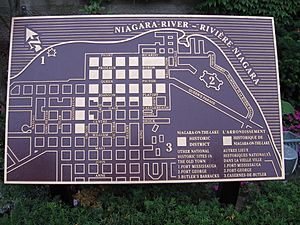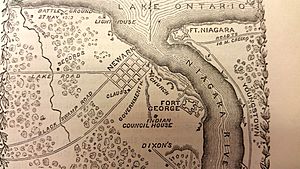Battle of Fort George facts for kids
Quick facts for kids Battle of Fort George |
|||||||
|---|---|---|---|---|---|---|---|
| Part of the War of 1812 | |||||||
 A historical marker, featuring Fort George. (#2) |
|||||||
|
|||||||
| Belligerents | |||||||
| Commanders and leaders | |||||||
| John Vincent | Henry Dearborn Winfield Scott Oliver Hazard Perry |
||||||
| Strength | |||||||
| 1,000 regular infantry, 300 militia, 50 natives, 5 field guns |
4,000 regular infantry, 1 corvette, 1 brig-of-war, 12 gunboats, Several batteries |
||||||
| Casualties and losses | |||||||
| 52-107 dead 147-175 wounded 276-280 captured (including 147-175 of the wounded) |
111 dead, 192 wounded |
||||||
| Official name: Battlefield of Fort George National Historic Site of Canada | |||||||
| Designated: | 1921 | ||||||
The Battle of Fort George was an important fight during the War of 1812. American forces attacked and captured Fort George from the British in Upper Canada. The United States Army and United States Navy worked together. They launched a successful attack from both land and water. Most of the British soldiers managed to escape before being surrounded.
Contents
Why the Battle Happened
Fort George was a key British fort on Lake Ontario. It was located on the west side of the Niagara River. Across the river was Fort Niagara, held by the Americans. Fort George was built to balance Fort Niagara. The British had lost Fort Niagara to the Americans in 1796.
Early Events in 1812
When the war started, both sides felt unprepared. In May 1812, British Governor General Sir George Prévost worried about Fort George. He thought it might not hold up against a large American attack. On the American side, Colonel Philetus Swift also worried about Fort Niagara. He thought it could fall to the British.
In October 1812, American Major General Stephen Van Rensselaer planned an attack. He wanted to attack Queenston first. This would draw British soldiers away from Fort George. Then, another American force would attack Fort George from behind. This plan did not work out. Bad weather stopped one attempt. Another part of the plan failed because a general did not cooperate.
Later in October, Van Rensselaer attacked Queenston without the other troops. This led to the Battle of Queenston Heights. During this battle, cannons at Fort George and Fort Niagara fired at each other. The American firing caused damage in Fort George. Several buildings burned down.
American Plans for Attack
In February 1813, the Americans made a new plan. They first planned to attack Kingston, then York. After that, they would attack Fort George. This plan changed because the American commander, Major General Henry Dearborn, thought Kingston had too many British soldiers. This was based on a false report.
On April 27, the Americans attacked York (today's Toronto). They captured the town and many supplies. But their general, Zebulon Pike, died in an explosion. After York, the American army moved to Fort Niagara. General Dearborn wanted to attack Fort George next. But his army needed rest and new supplies.
Preparing for the Attack
On May 15, Colonel Winfield Scott became Dearborn's chief of staff. Scott quickly improved the army's organization. He pushed forward the plans for the attack. At the same time, Commander Oliver Hazard Perry from the United States Navy helped. He explored the landing spots near the Niagara River. He placed marker buoys to guide the ships.
The Americans decided to land on the lake shore, not the river. Twelve small ships (schooners) with cannons would support the landing. Two larger ships, the Madison and the Oneida, would attack British cannons.
The American army had about 4,000 soldiers. They would land in four groups. Colonel Scott would lead the first group. Other generals like John Parker Boyd and William H. Winder would lead the next groups. General Morgan Lewis was in charge of the landing. General Dearborn watched from the ship Madison.
On May 25, the Americans started firing cannons at Fort George. They fired from their positions along the river and from Fort Niagara. The American ships also joined in. The British fired back with red-hot cannonballs. Several buildings inside Fort George caught fire. Women and children in the fort had to hide for safety.
British Situation
Brigadier General John Vincent was the British commander. He had about 1,000 regular soldiers. He also had up to 300 militia, including Captain Runchey's Company of Coloured Men.
General Vincent knew an attack was coming. But he did not know where it would happen. He split his soldiers into three groups. He thought the Americans would attack along the Niagara River. This was because Fort Niagara's cannons could cover that area.
The Battle Begins
The American attack did not come along the Niagara River. Just after sunrise on May 27, the morning fog cleared. It showed American ships off the lake shore. General Vincent saw many ships and boats.
Colonel Scott's troops began landing west of the Niagara River's mouth. Perry's schooners fired their cannons. They silenced the nearby British guns. A company of Glengarry Light Infantry charged the Americans. They used bayonets as the Americans waded ashore. Scott himself had to fight off a British soldier. The Glengarry company was outnumbered and had to retreat. They lost half their men. Another British company also attacked but suffered heavy losses from the ships' cannons.
Scott moved forward from the beach. But British troops counter-attacked him. These were the remaining soldiers who had fought Scott earlier. They also included five companies of the 8th (King's) Regiment. Scott was pushed back. But again, Perry's ships fired and caused many British losses. Scott's force was then joined by the first groups of Boyd's brigade. The British were pushed back again.
As more American troops landed, General Vincent realized he was outnumbered. He decided to pull his soldiers out before they were completely surrounded. He ordered a retreat south to Queenston. He also ordered the fort's cannons to be broken and the gunpowder storage areas to be blown up. But this was done too quickly. Scott's troops were too close. The Americans captured the fort mostly intact. One small gunpowder storage area did explode. The blast threw Scott from his horse and broke his collarbone.
Scott continued to chase Vincent's retreating soldiers. American cannons fired at the British from across the river. Vincent's rear guard fought back. They held off Scott, but some British soldiers were captured. The American plan included cavalry to cut off Vincent's retreat. But the cavalry was delayed. By the time they were ready, Scott had caught up to them. General Lewis then ordered Scott to stop the chase. Lewis worried that the British might lead Scott into a trap.
Casualties
The American army lost 111 soldiers killed. Another 192 were wounded. Colonel Scott's troops had 23 men killed and 66 wounded. General Boyd's brigade, which fought the hardest, had 88 men killed and 120 wounded. Other American brigades had fewer losses.
The British reported 52 killed, 44 wounded, and 262 missing. This included 16 wounded soldiers left in the fort's hospital. The local militia lost 5 officers and 80 other soldiers. The Americans reported taking 276 prisoners, with 163 of them wounded.
What Happened Next
The Americans won the battle. They captured a strong fort with fewer losses. This victory was due to good planning and leadership by Scott and Perry.
After the battle, General Vincent continued his retreat. He gathered his soldiers and fell back to Burlington Heights.
The Americans were slow to use their victory. They did not advance quickly up the Niagara peninsula. This allowed Vincent to launch a surprise attack later at the Battle of Stoney Creek. After that, the Americans pulled back to Fort George.
By focusing their ships on Fort George, the Americans left their own base open. The British tried to attack it at the Battle of Sackett's Harbor. But the Americans fought them off.
The Americans stayed in a small area around Fort George. After another loss at the Battle of Beaver Dams, they remained mostly inactive. They finally left Fort George in December 1813.
Commemoration
The battlefield where this fight happened was made a National Historic Site of Canada in 1921. Fort George itself also received this special designation in the same year.
Orders of Battle
| British Forces | American Forces |
|---|---|
|
Commander: Brigadier General John Vincent
|
Commander: Major General Henry Dearborn
Lake Ontario Fleet: Commodore Isaac Chauncey
|


